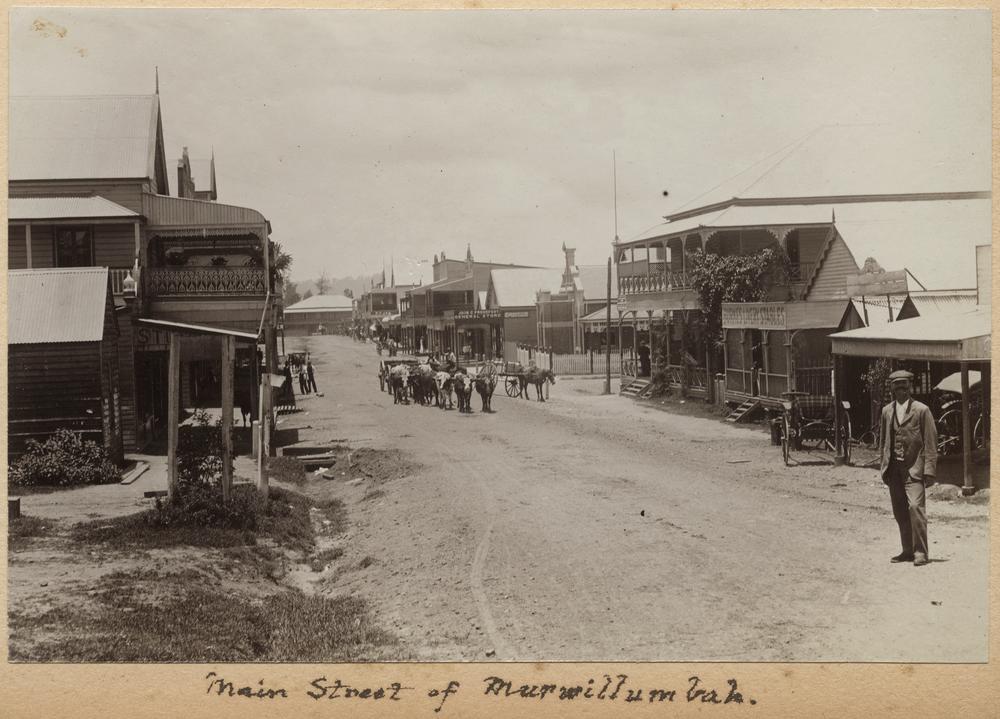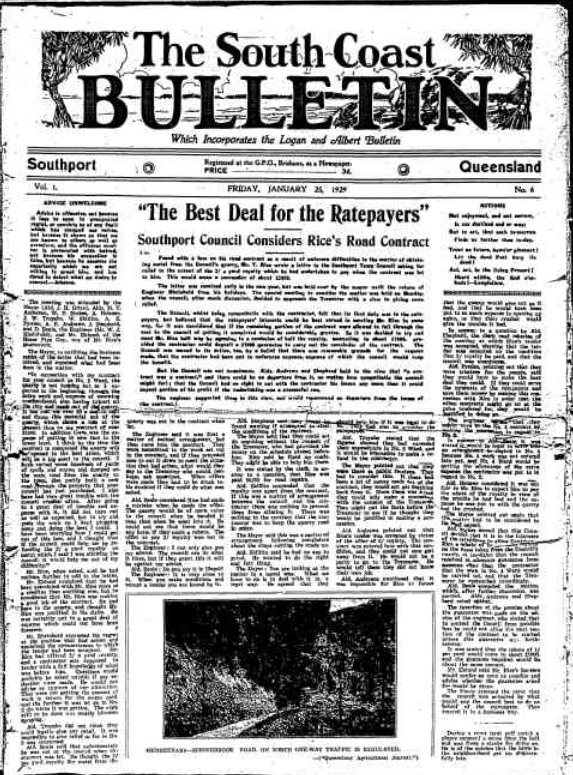|
Tweed Heads
Tweed Heads is a town in New South Wales. It is located on the Tweed River in north-eastern New South Wales, Australia, in Tweed Shire, next to the border with Queensland and adjacent to its "twin town" of Coolangatta, which is a suburb of the Gold Coast. It is often referred to as a town where people can change time zones – even celebrate New Year twice within an hour – simply by crossing the street, due to its proximity to the Queensland border, and the fact that New South Wales observes daylight saving whereas Queensland does not. History In 1823 John Oxley was the first European to see the Tweed Valley, and he wrote of it: "A deep rich valley clothed with magnificent trees, the beautiful uniformity of which was only interrupted by the turns and windings of the river, which here and there appeared like small lakes. The background was Mt. Warning. The view was altogether beautiful beyond description. The scenery here exceeded anything I have previously seen in Australia." ... [...More Info...] [...Related Items...] OR: [Wikipedia] [Google] [Baidu] |
Australian Eastern Standard Time
Australia uses three main time zones: Australian Western Standard Time (AWST; UTC+08:00), Australian Central Standard Time (ACST; UTC+09:30), and Australian Eastern Standard Time (AEST; UTC+10:00). Time is regulated by the individual state governments, some of which observe daylight saving time (DST). Australia's external territories observe different time zones. Standard time was introduced in the 1890s when all of the Australian colonies adopted it. Before the switch to standard time zones, each local city or town was free to determine its local time, called local mean time. Now, Western Australia uses Western Standard Time; South Australia and the Northern Territory use Central Standard Time; while New South Wales, Queensland, Tasmania, Victoria, Jervis Bay Territory, and the Australian Capital Territory use Eastern Standard Time. Daylight saving time (+1 hour) is used in jurisdictions in the south and south-east: South Australia, New South Wales, Victoria, Tasmania, Je ... [...More Info...] [...Related Items...] OR: [Wikipedia] [Google] [Baidu] |
Daylight Saving
Daylight saving time (DST), also referred to as daylight savings time or simply daylight time (United States, Canada, and Australia), and summer time (United Kingdom, European Union, and others), is the practice of advancing clocks (typically by one hour) during warmer months so that darkness falls at a later clock time. The typical implementation of DST is to set clocks forward by one hour in the spring ("spring forward"), and to set clocks back by one hour in the fall ("fall back") to return to standard time. As a result, there is one 23-hour day in early spring and one 25-hour day in the middle of autumn. The idea of aligning waking hours to daylight hours to conserve candles was first proposed in 1784 by U.S. polymath Benjamin Franklin. In a satirical letter to the editor of ''The Journal of Paris'', Franklin suggested that waking up earlier in the summer would economize on candle usage; and calculated considerable savings. In 1895, New Zealand entomologist and astronomer ... [...More Info...] [...Related Items...] OR: [Wikipedia] [Google] [Baidu] |
Tweed Daily
''The Tweed Daily'' was a daily English language newspaper published in Murwillumbah, New South Wales, Australia from 1914 to 1949. It was also published as the ''Tweed and Brunswick Advocate and Southern Queensland Record'', ''Tweed and Brunswick Advocate'', ''Tweed Times and Brunswick Advocate'', ''Tweed Herald and Brunswick Chronicle'', ''Tweed and South Coast Daily'', ''The Daily News'', ''Tweed and Gold Coast Daily News'', and the ''Tweed Daily News''. History The first edition of the ''Tweed and Brunswick Advocate and Southern Queensland Record'' was published by William Robert Baker on 31 October 1888. On 13 May 1903, it was renamed the ''Tweed and Brunswick Advocate'', published by John William Kilner. On 26 July 1905, publisher P.W. Tarlinton renamed it the ''Tweed Times and Brunswick Advocate'', also known as the ''Tweed Times''. In July 1893 George Niklin started publishing the ''Tweed Herald and Brunswick Chronicle'', also known as the ''Tweed Herald''. On 1 January ... [...More Info...] [...Related Items...] OR: [Wikipedia] [Google] [Baidu] |
Tweed Heads
Tweed Heads is a town in New South Wales. It is located on the Tweed River in north-eastern New South Wales, Australia, in Tweed Shire, next to the border with Queensland and adjacent to its "twin town" of Coolangatta, which is a suburb of the Gold Coast. It is often referred to as a town where people can change time zones – even celebrate New Year twice within an hour – simply by crossing the street, due to its proximity to the Queensland border, and the fact that New South Wales observes daylight saving whereas Queensland does not. History In 1823 John Oxley was the first European to see the Tweed Valley, and he wrote of it: "A deep rich valley clothed with magnificent trees, the beautiful uniformity of which was only interrupted by the turns and windings of the river, which here and there appeared like small lakes. The background was Mt. Warning. The view was altogether beautiful beyond description. The scenery here exceeded anything I have previously seen in Australia." ... [...More Info...] [...Related Items...] OR: [Wikipedia] [Google] [Baidu] |
Murwillumbah
Murwillumbah ( ) is a town in far north-eastern New South Wales, Australia, in the Tweed Shire, on the Tweed River. Sitting on the south eastern foothills of the McPherson Range in the Tweed Volcano valley, Murwillumbah is 848 km north-east of Sydney, 13 km south of the Queensland border and 132 km south of Brisbane. The town's name is often abbreviated to M'bah or Murbah. At the 2016 census, Murwillumbah had a population of 9,245. Many of the buildings are Art Deco in style and there are cafes, clothes shops and antique shops in the town. History The first people to live in the area were Kalibai people. The name Murwillumbah may derive from an Aboriginal compound meaning either "camping place" – from ''murrie'', meaning "aboriginal people", ''wolli'', "a camp", and ''bah'', "place" – or alternatively from ''murra'', "big", ''willum'', "possum", and ''bah''. Nearby Mount Warning and its attendant national park are known as Wollumbin, meaning "Cloud Catcher ... [...More Info...] [...Related Items...] OR: [Wikipedia] [Google] [Baidu] |
The Brisbane Courier
''The Courier-Mail'' is an Australian newspaper published in Brisbane. Owned by News Corp Australia, it is published daily from Monday to Saturday in tabloid format. Its editorial offices are located at Bowen Hills, in Brisbane's inner northern suburbs, and it is printed at Murarrie, in Brisbane's eastern suburbs. It is available for purchase throughout Queensland, most regions of Northern New South Wales and parts of the Northern Territory. History The history of ''The Courier-Mail'' is through four mastheads. The ''Moreton Bay Courier'' later became '' The Courier'', then the ''Brisbane Courier'' and, since a merger with the Daily Mail in 1933, ''The Courier-Mail''. The ''Moreton Bay Courier'' was established as a weekly paper in June 1846. Issue frequency increased steadily to bi-weekly in January 1858, tri-weekly in December 1859, then daily under the editorship of Theophilus Parsons Pugh from 14 May 1861. The recognised founder and first editor was Arthur Sidney Lyon (18 ... [...More Info...] [...Related Items...] OR: [Wikipedia] [Google] [Baidu] |
Australian Railway History
''Australian Railway History'' is a monthly magazine covering railway history in Australia, published by the New South Wales Division of the Australian Railway Historical Society on behalf of its state and territory Divisions. Australian Railway Historical Society History and profile It was first published in 1937 as the ''Australasian Railway and Locomotive Historical Society Bulletin'', being renamed ''ARHS Bulletin'' in 1952. In January 2004, the magazine was re-branded as ''Australian Railway History''. Historically, the magazine had a mix of articles dealing with historical material and items on current events drawn from its affiliate publications. Today, it contains only historical articles, two or three of them being in-depth.Parameters * Size : A4; ...[...More Info...] [...Related Items...] OR: [Wikipedia] [Google] [Baidu] |
Brisbane, Queensland
Brisbane ( ) is the capital and most populous city of the states and territories of Australia, Australian state of Queensland, and the list of cities in Australia by population, third-most populous city in Australia and Oceania, with a population of approximately 2.6 million. Brisbane lies at the centre of the South East Queensland metropolitan region, which encompasses a population of around 3.8 million. The Brisbane central business district is situated within a peninsula of the Brisbane River about from its mouth at Moreton Bay, a bay of the Coral Sea. Brisbane is located in the hilly floodplain of the Brisbane River Valley between Moreton Bay and the Taylor Range, Taylor and D'Aguilar Range, D'Aguilar mountain ranges. It sprawls across several local government in Australia, local government areas, most centrally the City of Brisbane, Australia's most populous local government area. The demonym of Brisbane is ''Brisbanite''. The Traditional Owners of the Brisbane a ... [...More Info...] [...Related Items...] OR: [Wikipedia] [Google] [Baidu] |
South Coast Railway Line, Queensland
South is one of the cardinal directions or compass points. The direction is the opposite of north and is perpendicular to both east and west. Etymology The word ''south'' comes from Old English ''sūþ'', from earlier Proto-Germanic ''*sunþaz'' ("south"), possibly related to the same Proto-Indo-European root that the word ''sun'' derived from. Some languages describe south in the same way, from the fact that it is the direction of the sun at noon (in the Northern Hemisphere), like Latin meridies 'noon, south' (from medius 'middle' + dies 'day', cf English meridional), while others describe south as the right-hand side of the rising sun, like Biblical Hebrew תֵּימָן teiman 'south' from יָמִין yamin 'right', Aramaic תַּימנַא taymna from יָמִין yamin 'right' and Syriac ܬܰܝܡܢܳܐ taymna from ܝܰܡܝܺܢܳܐ yamina (hence the name of Yemen, the land to the south/right of the Levant). Navigation By convention, the ''bottom or down-facing side'' of ... [...More Info...] [...Related Items...] OR: [Wikipedia] [Google] [Baidu] |
Queensland Railways
Queensland Rail (QR) is a railway operator in Queensland, Australia. Owned by the Queensland Government, it operates local and long-distance passenger services, as well as owning and maintaining approximately 6,600 kilometres of track and related infrastructure. QR was also responsible for all Queensland freight services, and from 2002 operated interstate services under the Australian Railroad Group, Interail and QR National brands. These were all spun out into a separate entity in July 2010, and later privatised as Aurizon. History Beginnings Queensland Railways was the first operator in the world to adopt narrow gauge (in this case ) for a main line, and this remains the systemwide gauge within Queensland today. The colony of Queensland separated from New South Wales in 1859, and the new government was keen to facilitate development and immigration. Improved transport to the fertile Darling Downs region situated west of Toowoomba was seen as a priority. As adequate river ... [...More Info...] [...Related Items...] OR: [Wikipedia] [Google] [Baidu] |
Southern Queensland Bulletin
The ''Gold Coast Bulletin'' is a daily newspaper serving Australia's Gold Coast region. It is published as ''The Gold Coast Bulletin'' on weekdays and the ''Weekend Bulletin'' at weekends. It is owned by News Corp Australia. History The newspaper has undergone a number of masthead and ownership changes. When Patrick Joseph McNamara started the paper in 1885, he worked in a tin shed on Southport's Lawson Street. He named the paper ''The Southern Queensland Bulletin'', and it was the first newspaper published in Southport. McNamara was succeeded by Mr Shepherd and Mr Mellor. In the 1890s, the broadsheet was renamed to ''The Logan and Albert Bulletin'', and kept this name until 1928. It was during this period that the Rootes family became associated with the paper, a relationship that spanned generations and provided stability to the publication. In 1908 Mr Edward Fass purchased the newspaper and sold his interest in 1928. On 21 December 1928, under the editorship of Mr Mic ... [...More Info...] [...Related Items...] OR: [Wikipedia] [Google] [Baidu] |








